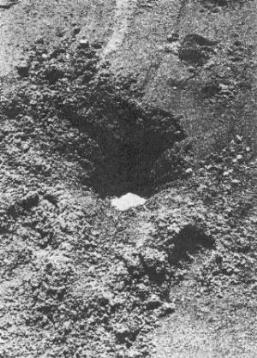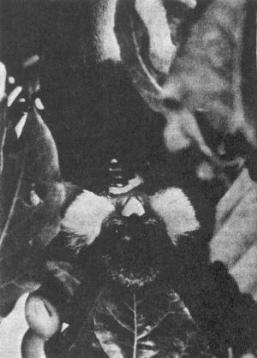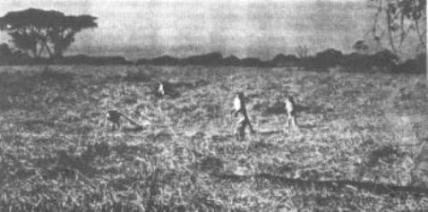

| Proc. Gabon Nature Soc. (1987), 277(3):47-60. |
|
Burrowing Behavior of Wild Bluetail
Monkeys at the Makokou Study Area, Gabon |
|
Dr. Oondóué M. Boué
Academie Republique Gabonaise and Reginald Pennyworth Maudlin-Jones Cheltenham-on-Bath Primatology Center |
| ABSTRACT. During nineteen years (1967-1985) of research on wild forest guenons at the Makokou Study Area, Gabon, burrowing behavior of Cercopithecus subterraneus was documented by observations totalling 8,620 hours, including 290 whole days (when the target animal was followed from burrow to burrow). Data was collected on 56 individually recognized guenons, including 13 adult males, 19 adult females, and 24 sub-adults, in an attempt to illuminate the question of whether this behavior is adaptive or pathological. Although burrows were excavated approximately once a week, 27% of those utilized were holes vacated by Gabonese black-footed forest gophers. Burrows were used for night nests, and as places to hide when danger threatened. Bluetails seemed to be alarmed by any and all sounds in the forest, and often spent all day in their burrows. Sub-adults were frequently observed eating earth, and it is hypothesized that adults forage underground for roots, bulbs, grubs and insects to avoid having to be outside during the daytime. |
|
Cercopithecus
subterraneus, also known as the bluetail monkey or bluetail guenon,
has the distinction of being the world's only burrowing primate. The
species was named by its discoverer, Sir Rodney Billingham-Applegate,
in 1946, when he saw what he identified as an adult male diving into its
burrow in the ground. Almost a decade earlier, while completing
a census of the diurnal primates of the Umbugwe Forest, he had been startled
by the sudden appearance of an individual of a previously unknown species
of guenon from a hole next to the lawn chair in which he was relaxing,
and he spent the next eight years in a lonely and often frustrating search,
enduring the frequently sarcastic disbelief of co-workers and detractors
alike, before once again seeing the characteristic white chin tufts that
have since become so well known and that are one of the morphological
hallmarks of this shy and secretive anthropoid (Billingham-Applegate,
1946). |
|
Observations
of bluetail burrowing behavior were made between June 1967 and February
1985 at the 17 sq. mile Makokou Study Area in the Ivindo River Forest
Reserve which is part of Jambili National Park located in the Makanza
Mountains of northeastern Gabon. Details of this study are available
elsewhere (Boué, 1978, 1979a, 1979b, 1981, Boué and Maudlin-Jones,
1983). Unlike other guenons and indeed most monkeys and apes, C.
subterraneus is predominantly solitary; adult males live alone while
females are accompanied only by dependent young. In this regard,
the anthropoid closest to this social pattern would be the orangutan. |
|
Burrow construction
at the Makokou Study Area was observed on 197 occasions. Adult males
dug 45 burrows (22.8% of total), adult females dug 98 burrows (49.7% of
total), and independent sub-adults dug 54 burrows (27.5% of total). Sub-adults
began digging their own burrows at approximately three years old for males
and three and a half years old for females. Before the onset of
independent burrow construction, all juveniles shared their mother's burrow.
The fact that males dug 22.8% of the total number of burrows that
were observed being constructed while only accounting for 11.4% of total
observation time is explicable by the slightly shorter periods they remained
in each burrow before abandoning it, and by the female adults' reticence
at digging burrows while someone was watching them. Females and
sub-adults dug new burrows on average roughly once a week, while adult
males dug new burrows every 5-6 days. Samples of earth and nesting
material from recently abandoned burrows contained large quantities of
fecal parasites of a species that incubates in 8-10 days, therefore it
is assumed that bluetails leave their burrows before they can be reinfected
by these parasites (Jernigan, 1982). |
 |
 |
|
Fig. 1. Bluetail burrow entrance.
|
Fig. 2. Bluetail peering out from Ibounzi
vines.
|
the strength of adults and consequently their burrows are not excavated as deeply. They tend to scrape up fistfuls of decaying leaf matter around the entrances of their burrows to increase the effective dimensions of the nesting space, but even so they are sometimes seen lying on the ground shivering in fright, with only a few twigs to cover them and create the illusion of a burrow. Burrow construction took place most frequently during the middle part of the day, when other animals could be expected to be resting and inactive. The typical pattern was for the bluetail to creep stealthily out of its burrow, spend about thirty minutes listening and watching for anything that might threaten its safety, then move rapidly to a new location usually at least 100m but not more than 200m away, following which it would spend half an hour making sure it had not been followed. Only then would actual digging commence. In 89.3% of observed burrow excavations, bluetails approached their chosen site rearwards, using their powerful tarsier-like legs and clawed feet (Atherington, 1981) to scoop out the beginnings of the burrow while remaining alert for any noise or movement in the surrounding forest. Only when the burrow was deep enough to conceal themselves in did they reverse their position and continue digging with their hands. Time of construction normally was approximately two hours, although it ranged from a minimum of 50 minutes in the case of one particularly nervous individual to a maximum of several days when the burrow walls kept caving in or when the ground was especially hard. Once the excavation has been completed, bluetails line their nests inside with mosses and birdclaw ferns which they customarily steal in surreptitious raids on neighboring burrows. It frequently occurs that when they are out on these raids, other bluetails are stealing their nesting materials. By attaching a transmitter to a particularly attractive clump of moss, the German primatologist Eric Scotmeister Fleiglehaus was able to document its appearance in the burrows of nine different bluetails in a period of just twenty-two minutes. |
|
Bluetail
burrowing frequency varies seasonally, but not at all times of the year.
C. subterraneus spends most of its time underground. As
might be expected, adult males are the most adventurous, and can often
be seen peeking bravely out of their burrow entrances. During times
of vegetational abundance, males spend an average of three and a half
hours a day foraging quietly for the young leaves of several low-growing
forest shrubs, and supplement their diets at other times with insects,
grubs and rotting bark. Females are more cautious and usually more
sedentary, commonly remaining in their burrows until ten or eleven AM
and returning to them shortly after noon, unless they are digging a new
burrow. |
|
Table 1
|
| Mean daily hours spent in burrows |
|
|
Jan/Feb 18.8 |
Mar/Apr 18.9 |
May/Jun 19.2 |
Jul/Aug 20.1 |
Sep/Oct 20.2 |
Nov/Dec 18.1 |
|
Burrowing as an adaptive behavior Adaptive
behaviors are those that permit the animal to adapt, and thus better to
survive and/or reproduce. Therefore, in order for it to be shown that
burrowing is adaptive, two things must be demonstrated: first, that
individuals must vary in the degree to which they carry on this behavior,
and second, that these variances must correlate in some way to success
in surviving and reproducing. To put it simply, the advantages
of burrowing must outweigh the disadvantages. |
|
If burrowing
can not be shown to be an adaptive behavior, should we not then think
of it as pathologic? This is the theory put forward last year by
Teddy Preston and Frank Keith at the Primates Symposium held at Bob Jones
University in South Carolina, and it is one to which we confess to being
strongly drawn. For one thing, the total biomass of primates at Makokou
is obviously much less than at Kibale in Uganda or at Kuala Lompat in
Malaysia, while the available food sources are approximately equivalent
(Boslington, 1983; Billabong, 1985; Preston and Keith, 1986). The
carrying capacity of the arboreal environment has thus not been reached,
and there is no doubt that there are several niches that could be better
utilized first without resorting to the dire expediency of going underground. |
|
Table 2
|
|
Things which most commonly frighten Claps of thunder |
Percentage of total 1.2 |
Furthermore, no degree of habituation was achieved over the nineteen year period, and C. subterraneus target animals appeared to be just as nervous and scared at the presence of observers at the conclusion of the study as at its inception. Of course, while observing animals in the wild, it is very difficult to attribute any particular behavior to specific emotional states such as fear without anthropomorphising the subjects. But certain behavioral traits in bluetails have |
 |
|
Fig. 3. Bluetails frantically searching
for their burrows
in an area of recently cleared vine forest. |
been commonly observed which seem to evidence fear or something like it. Of 862 incidents in which an observer happened upon a bluetail in the forest, in 790 cases the bluetail's eyes widened measurably and the lips were drawn back in what was taken to be a grimace of fear. Teeth were heard clacking at distances of up to 50 meters in 527 instances. The ducking of the head has been well-observed and described elsewhere (Bongo, 1980), and it will suffice to say here that it is widely practised and is probably a defensive tactic. Their most amazing behavior of all is their ability to suck in their stomachs in order to appear scrawny and not worth a predator's trouble. When they are startled, bluetails at least 70% of the time will automatically deflate their stomachs and lie about on the ground looking pathetic (Boué, 1986). In other cases, if their burrow is not nearby, the bluetail will attempt to hide under a large leaf. There is also fossil evidence of a severe population decline since the Pleistocene when bluetail guenons were the most prolific and wide-ranging species of their genus, and there would not seem to be any way that their population could have been so large and they so reproductively successful had they followed their present behavioral patterns. Not only is there no other guenon that burrows, there is no other primate that burrows. In fact, burrowing goes against most of what a primate is. There is nothing in the fossil record that indicates that primates have ever burrowed. Therefore, it appears that C. subterraneus has colonized a niche that is totally inappropriate for its taxa, based on 60 million years of primate evolution. But however inappropriate, this behavior could still be shown to be adaptive if it conveyed some advantage to the individual concerned, or to the group as a whole, either for survival or reproduction. We were unable to document such an advantage. To the contrary, the disadvantages are numerous, as has already been outlined. |
|
Nineteen years was unfortunately not a sufficient length of time to determine whether bluetail burrowing behavior is adaptive or pathologic. Although this activity could not be shown to be adaptive, there may be some selective advantages that we are as yet unaware of, and that we may have been unable to discern. However, the evidence for its being a pathologic behavior based on extreme fearfulness is mounting. We are returning to Gabon next month for the second phase of our study, and we very much hope to have a definitive answer before long. |
|
Acknowledgements The guenon
research on which this paper is based was funded by the Woodrow Wilson
Old World Monkey |
|
References |
|
Anderson, Philander P. and Richards, Michael Sorenson (1975). "The Bluetails of Kibale." Ugandan Forest Weekly, 1:1. Atherington, Arthur A. (1981). "Morphological adaptations of bluetail guenons." Afr. Stud. Monogr., 12:75-91. Bayswater, Arthur Presley (1975). "Infant mortality rates in C. subterraneus, C. nictitans, C. cephus, C. pogonias, C. mitis, C. campbellii, and C. ascanius. In Predation on Primates in the Pleistocene (ed. Parker L. Quiddy). New York, Jay Press. Billibong, Matilda T. (1985). "Bluetails: Just How Blooming Big Are These Little Buggers?" Australian-Samoan Nature Journal, 82:12-20. Billingham-Applegate, Rodney (1946). "How I Discovered a New Species of Monkey whilst Relaxing in the Forest and Enjoying a Mint Julep." Arch. Brit. Explor. Soc., 212:56-81. Bongo, N'Bana (1980). "Description and analysis of the head-dipping display in the Gabonese bluetail." Rain Forest Notes, 22:41-58. Boslington, Franklin R. (1982). "Vegetational zones of the Ivindo River Forest Reserve." Biotropica, 14:50-110. Boslington, Franklin R. (1983). "Biomass parameters for several endangered rain forest refugia." Nature, 310:88-131. Boué, Oondóué M. (1978). "Water retention characteristics of Gabonese montane forest soils." J. West African Trop. Soc., 56:22-39. Boué, Oondóué M. (1979a). "Foraging strategies of bluetail monkeys at the Makokou Study Area, Gabon." Primates, 20:79-94. Boué, Oondóué M. (1979b). "Seasonal variation in day-range distance of Cercopithecus subterraneus." Primates, 20:185-210. Boué, Oondóué M. (1981). "Spitting proclivities of adult male bluetail guenons in the Ivindo River Forest Reserve of Gabon." Int. J. Primat., 2:112-186. Boué, Oondóué M. (1986). "Stomach deflation as a defensive tactic in adult C. subterraneus at Makokou." Proc. Gabon Nature Soc., 273:120-140. Boué, Oondóué M. and Maudlin-Jones, Reginald Pennyworth (1983). "Bluetail monkey burrowing behavior as a possible model for early Bantu cave construction." J. Human Evol., 12:125-163. Cooper, Felicia and Somers, E.B. (1983). "DNA chromatization tests and cercopithecine longevity." Int. J. Primat., 4:72-92. Delaney, Lilian and MacArthur, Alice (1975). "C. subterraneus: a case of sociobiological paranoia." Contrib. Primat., 5:27-41. Englanberg, Leif and Petersen, Olaf (1953). Two Came Back. Reykjavik, Viking Press. Fleiglehaus, Eric Scotmeister (1978). "Going down a monkey hole with nothing but a Swiss Army knife." Unnatural History, October, pp. 12-119. Fleiglehaus, Eric Scotmeister (1984). "Tracking wild moss by radio in the African jungle." Z. Tierpsychol., 52:12-14. Galtner, Ashworthy (1979). "Use of vacated rodent holes by Central African bluetail monkeys." Folia Primat., 31:52-62. Harrison, Thomas L. (1981). "Effects of inbreeding on infant burrowing tendencies in captive guenons at the Frankfurt Zoo." Nature Review, 50:22-45. Hicks, T.B. (1981). "The fleeing response in four allopatric sub-Saharan cercopithecines and its relation to home range size." Primates, 22:45-73. Jernigan, P. Wilkes (1982). "Bluetail parasites and other interesting creatures." Microzoology Review, 12:91-105. Knuckleberry, Alexander (1952). "Population density and biomass of several primate species south of the Ubangi-Congo River system." Ann. 12th Congress Evol. Soc., Vol. IV, 159-220. Landershot, Albert Prince (1976). "Niche separation between Cercopithecus cephus and C. subterraneus." In Equatorial Forest Mammals (ed. Marcel Gagneuil). Paris, LaFarge Technical Institute Press. Masters, Arthur Barrett (1982). "Congeneric sympatry of Gabonese forest guenons." Int. J. Primat., 3:127-154. Nataka, Bonzai (1975). "It's no fun being sick in Africa." Afr. Trop. Diseases Monthly, 112:29-51. Ohhohoho, Mitsuo (1968). The Professor Mitsuo Ohhohoho Primate Identification Book and African Jungle Survival Guide. Tokyo, Edo University Book Binders. Parkes, B.L., Parkes, C.D., Parkes, H., Parkes, H.H., Parkes, J., Parkes, L.T., Parkes, M., Parkes, M.T., Parkes, R., Parkes, R.E., Parkes, R.E.L., Parkes, S., Parkes, T.T., Parkes, W.E., Parques, Francois and Smith, Basil (1977). "Sub-terrestrial foraging of bluetail monkeys at Makokou Study Area, Gabon." Quart. Review Forest Biol., 52:1-2. Preston, T.L. and Keith, Franklin (1986). "New data on cercopithecine primates of the Umbugwe." Centr. Afr. Forest J., 20:502-597. Preston, T.L. and Keith, Franklin. Primate Psychology and Aberrant Behavior Patterns. (In preparation) Railsback, R. and Foyémé, Mbu (1986). Primate Nesting Behavior. Libreville, Albert Schweitzer and Co. Roberts, Letitia P. (1984). The Burrowing Guenon of Gabon. Ontario, St. Paul's Press. Shaw, Christopher (1986). "Burrow excavation can be a tricky business." Reader's Digest, 859:79-84. Spouty, Ralph. "Hunting the Hell Monkey of Gabon." Field and Stream, Dec. 1955, 58-68. Stilwell, Roger B. (1969). "Creation myths among the Fang in the Ogoóué Basin of Gabon." Central Afr. J. Anthrop., 27:12-56. Takahashi, S. and Nishida, R. (1987). "Discovery of sub-fossil guenons in Gabonese caves on the Ivindo River." Nature, 325:56-61. Waters, Delores McKenzie (1964). The Week of the Bluetail. Akron, Shoestring Press. Williker-Rogers, Maxine. "The Bluetail: Yet Another Example of Female Superiority in Nature." Ms, Sep. 1972, 23-27. Williker-Rogers, Maxine (1973). "Mobbing behavior of wild bluetail monkeys in Central Africa." Primates, 14:90-102. |
|